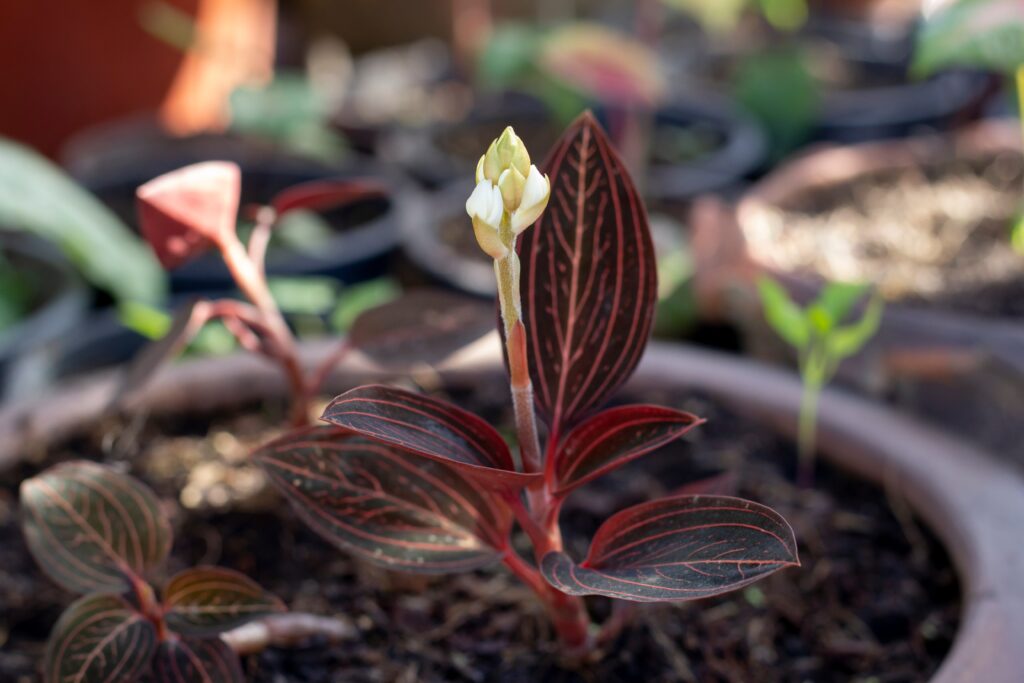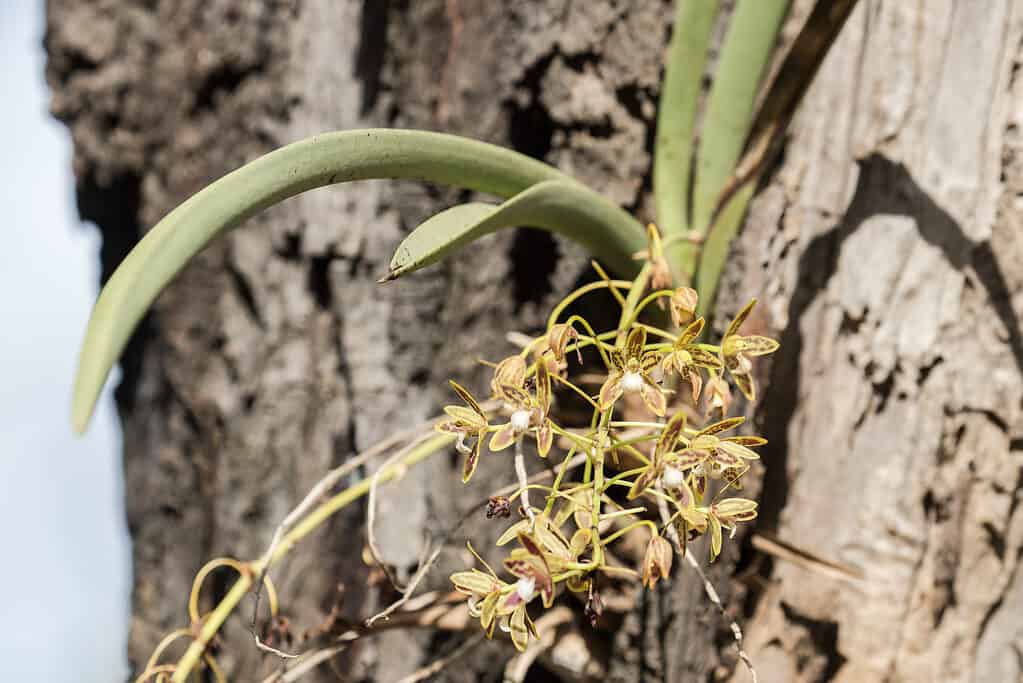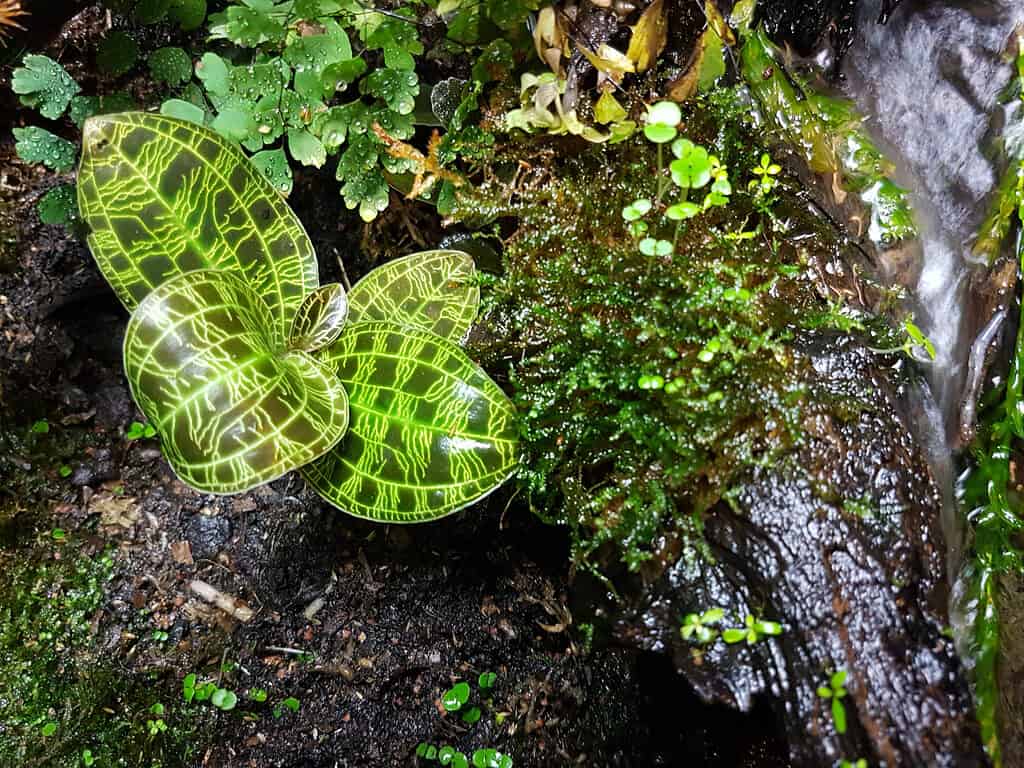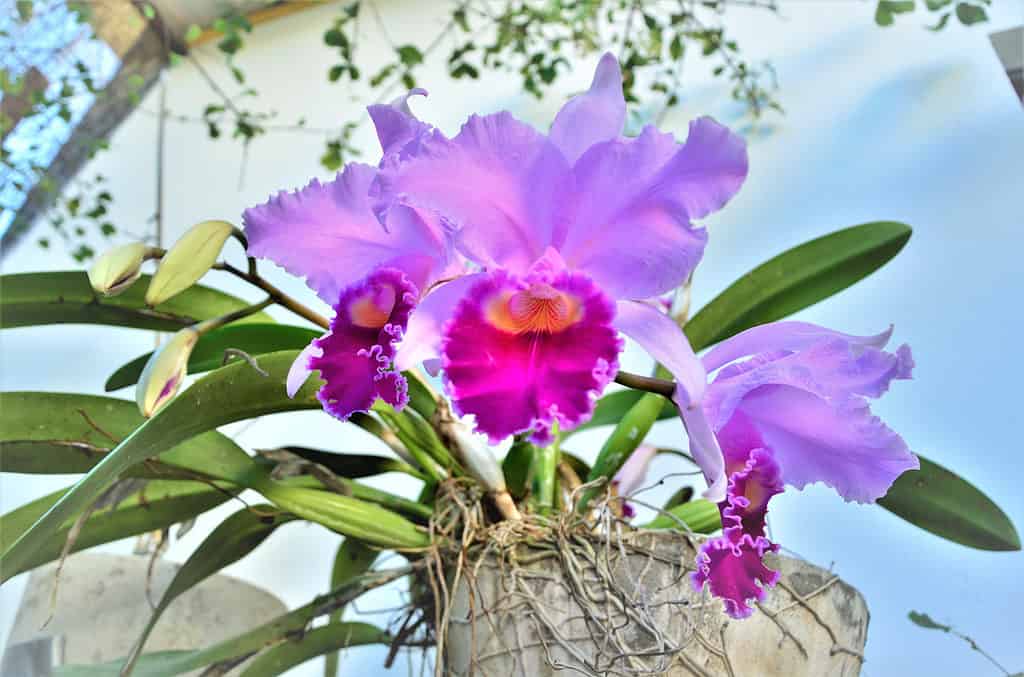Gardeners love cultivating orchids for their astounding range of flower shapes, fragrances, and colors. Some species also produce dazzling foliage, such as jewel orchids and mottled-leafed paphiopedilums.
In this orchid growing guide, we’ll help you develop a strong foundation for successfully growing your orchids by providing a thorough guide on the basics of orchid care. We’ll cover everything from their botanical classification, basic care requirements, differences in care between epiphytic and terrestrial species, and define terms you’ll often see in orchid care such as TDS.
Alright, let’s get to it!

Some species of orchids, such as jewel orchids, produce stunning foliage.
©TuktaBaby/Shutterstock.com
Orchids: Botanical Classification
The Orchidaceae family contains all 28,000 currently recognized species of orchids across 880 genera, making it the most diverse botanical family of flowering plants. Not only do orchids produce a stunning array of blooms and foliage, they also grow in an impressive range of environments around the world. Orchids natively grow on every continent except Antarctica and inhabit both temperate and tropical climates.
However, they have evolved over the millions of years to thrive in an arboreal lifestyle, attaching to tree bark non-parasitically as epiphytes. It is within this environmental niche that orchids truly shine, and currently over 80% of all orchid species live as tropical and subtropical epiphytes. The remaining species live either as lithophytes, clinging to rocks, or as terrestrials, growing with their roots in the soil as orchids originally lived when they first emerged on Earth about 120 million years ago.

Currently over 80% of all orchid species live as tropical and subtropical epiphytes, attaching to tree bark non-parasitically.
©iStock.com/JillianCain
Orchid Care: Setting the Foundations
To successfully grow orchids, it’s crucial to become familiar with the main types of orchids and their growing environments. What type of orchid you have will determine its care requirements. The basic categories one can divide orchids into are as follows:
- subtropical and tropical epiphytes
- temperate terrestrials
Some species, as we mentioned above, are also lithophytic or a combination epiphytic and lithophytic. Some are also semi-terrestrial, growing attached to leaf litter, and have care requirements closer to epiphytes than terrestrials. All of these species will have care needs that fall into non-terrestrial guidelines and often mirror epiphytic care, although temperature range requirements can vary greatly by their native climates.
Below, we’ll talk about these two general categories and introduce some broad growing guidelines to follow. Keep in mind that you’ll need to further hone your care to specific species or genus-based care requirements. But, the following information will help get you solidly on the right track.
Orchid Growing Guide: Tropical and Subtropical Epiphytes

Epiphytic orchid roots, while they need to stay moist, do not handle saturated growing mediums and need a high level of aeration.
©Ken Griffiths/Shutterstock.com
Since the vast majority of orchids fall into this category, it’s highly likely that you’ll grow orchids in this group, unless you develop a particular affinity for only terrestrial species. These plants are particularly well-suited for indoor growing. For epiphytic orchids, you’ll need to understand how their growing environment is distinct from terrestrial plants.
So, epiphytes obtain moisture direct from the air humidity and rainfall, and they uptake nutrients from the air, through organic debris found on bark and moss, and through beneficial plant-fungi nutrient exchanges. Their roots are exposed to the air, where they typically don’t fully dry out, even during the dry season, due to high air humidity in their native environments. Epiphytic orchid roots, while they need to stay moist, do not handle saturated growing mediums. They require a high level of aeration in order to survive.
Most epiphytes develop pseudobulbs that store water and nutrients during the winter dry season common in tropical and subtropical environments. During their growing phase in the wet season, they obtain small, frequent amounts of nutrients through the above-described methods and don’t do well with large doses of nutrients as mineral and salt buildup can quickly damage their delicate root system.
Subtropical and tropical environments tend to experience mild, rather uniform temperatures year-round, but they also have drops in temperature of about 10-15 degrees at night. Epiphytes usually need to experience this temp drop to successfully grow and bloom.
Finally, most epiphytes grow under dense forest canopies and receive filtered sunlight. You’ll typically want to grow these plants in varying levels of indirect sunlight.
Applying Info on Native Epiphytic Orchid Environments to Growing Guidelines
All of the above-mentioned information is crucial to know as an orchid grower as you will need to closely replicate this native environment to successfully grow epiphytes. So, to synthesize this info for growing epiphytes, it’s important to follow these general growing guidelines:
- Use a soilless potting mix that supports fast-draining and plenty of aeration. Various sizes of chopped bark, sphagnum moss, perlite, and lava rock are all popular mix choices for growing epiphytic orchids.
- Water heavily during the growing phase, while avoiding saturating the growing medium, and cut back on watering your orchid during the late fall and winter to mimic the natural environment. Some species need to dry out completely during its rest phase, so always consult species-specific growing guides.
- Fertilizer “weekly weakly” during the growing phase with a water-soluble, balanced orchid fertilizer at 1/4-1/3 the recommended growth. Cut back during the rest phase to about once a month for most species.
- For most epiphytes, place your plant in indirect sunlight. The intensity of the light depends on the genus of orchid. For instance, Phalaenopsis orchids prefer low indirect, sunlight, while Cattleya orchids tend to prefer very bright, indirect sunlight. Again, consult genus or species-specific growing guides.
- For orchids native to growing in tropical and subtropical environments, providing high humidity levels is crucial. Alternatively, you can commit to misting twice a day to replicate these conditions. You’ll want to aim for at least 50% humidity, with some species requiring over 70%.
Remember, lithophytes and semi-terrestrial species tend to need similar care to epiphytes specifically regarding soilless growing substrates, fertilizing, and watering requirements. If they grow in cooler environments, such as the mountainous lithophytic species, Angraecum sororium, the temp requirements will be much cooler. As always, consult species and genus-specific guidelines to fine tune plant care.
Orchid Growing Guide: Temperate Terrestrials

Temperate terrestrials such as the jewel orchid
Macodes petolafeature impressive variegated foliage.
©Thanes Pruttivanichakul/Shutterstock.com
The other broad category of orchids is temperate terrestrial species. Jewel orchids are a widely popular group of terrestrial orchids that feature stunning variegated foliage. Macodes petola is an example of a well-loved terrestrial species with stunning leaf variegation.
The native habitats for terrestrials ranges from dense woods to semi-wooded areas to bogs and open meadows. All terrestrials thrive in well-draining, fertile, and well-aerated soil. Like their epiphytic relatives, they don’t survive well in soggy soil and can quickly succumb to root rot.
Many species have basally-arranged foliage that emerge at ground level and gracefully surround a central stem from which flowers emerge. They often live in cool-to-warm, temperate environments that experience rainfall distributed throughout the year and distinct seasonal variation in temperatures.
Most terrestrial orchids experience a dormant phase in which they must be exposed to cool-to-cold temperatures in order to trigger growth in the late winter to spring. Often, these orchids needs 2-4 months of cold temperature exposure to trigger spring growth. It’s important to know that their roots system is protected from hard freezes not only from the soil but also several inches of leaf and plant litter that falls in the autumn.
It’s also important to always check the genus or species-specific growing guide for terrestrial orchid temperature requirements as some species are quite warm-growing and native to more subtropical environments, such as mottle-leaf paphiopedilums.
Terrestrial orchids can grow in a wide range of sunlight exposure, from the downy rattlesnake plantain orchid (Goodyera pubescens) that thrives in almost full shade, to Spiranthes ceruna which grows in moist meadows and can thrive in almost full sun.
Unlike their non-terrestrial relatives, these orchids don’t fare well with constant fertilizing as they tend to obtain all the nutrients they need from the soil (which includes soil-dwelling mycorrhizal fungi).
Applying Info on Native Terrestrial Orchid Environments to Growing Guidelines
Growing terrestrial orchids is certainly more of a familiar process to most gardeners since they grow in the soil or soil-based potting mixes. To help them thrive, you’ll want to follow these general guidelines:
- Grow in a soil-based growing substrate that is well-draining and aerated. Loamy soil is an excellent choice for most terrestrial orchids. You can add perlite and chopped sphagnum moss to the mix as well to improve drainage while ensuring enough moisture retention. Repot once per year or so with fresh substrate to replenish the nutrients in the mix.
- Consult a genus or species-specific growing guide to provide adequate lighting. Light requirements can range from low, indirect sunlight to almost full sun.
- Water consistently throughout the year, with a small reduction during the winter. Remember, temperate environments don’t tend to experience distinct wet and dry seasons, so water accordingly. Ensure the growing substrate is consistently moist but not soggy.
- Provide sufficient cold exposure during the dormancy phase for species that require this. You’ll need to ensure that the duration of exposure and temperature drop is adequate.
- Generally, temperate terrestrial species require moderate humidity level between 30-50%.
- Be wary of over-fertilizing. Most guides suggest fertilizing once every 2-3 months with a variety of nutrients such as blood and bone meal, a balanced orchid fertilizer, and liquid seaweed.
How to Care for Orchids: Terms to Know

Epiphytes typically do best when grown in water that contains total dissolved solids of less than 175 ppm to mimic their native environment.
©NANCY AYUMI KUNIHIRO/Shutterstock.com
One term that you’ll frequently come across when perusing literature about orchid care is TDS. This term stands for “total dissolved solids” and describes the total amount of solids in water that are less than 2 microns in size. These solids include both organic and inorganic matter such as salts, minerals, and microscopic organic debris. The amount of total dissolved solids in water is measured by parts per million (ppm) or mg/liter.
You’ll especially want to become familiar with these terms when growing epiphytes as many species do best when grown in water that contains total dissolved solids of less than 175 ppm. The reason for this is because they naturally receive water from sources that don’t contain high concentration of TDS, such as rainwater and air humidity. Groundwater naturally contains much higher sources of TDS from all the compounds in the soil. You’ll find that many terrestrial species thrive perfectly well with TDS levels at or below 500ppm.
Orchid Growing Guide: Common Problems to Watch Out For
Like with any plant, you can run across a variety of problems when growing your orchids. These issues include the following:
- wilting
- darkening leaves
- burnt or reddening leaves
- yellowing or crisping leaves
- lack of blooming
- lack of new growth in the spring
- root rot
All of these problems stem from a fundamental issue with care that relates to either over or under exposure of sunlight, under fertilizing, over or under watering, growing in the wrong substrate, and not exposing the orchid to proper temperatures. To solve issues with your orchid, the first step is to take a step back and consult a species or genus-specific growing guide for your plant. Can you confirm that you’re following the guidelines or is there a hole in your care routine? Once you define what the problem is, you can adjust according to the needs of your plant.
The photo featured at the top of this post is © iStock.com/wisan224
Thank you for reading! Have some feedback for us? Contact the AZ Animals editorial team.







